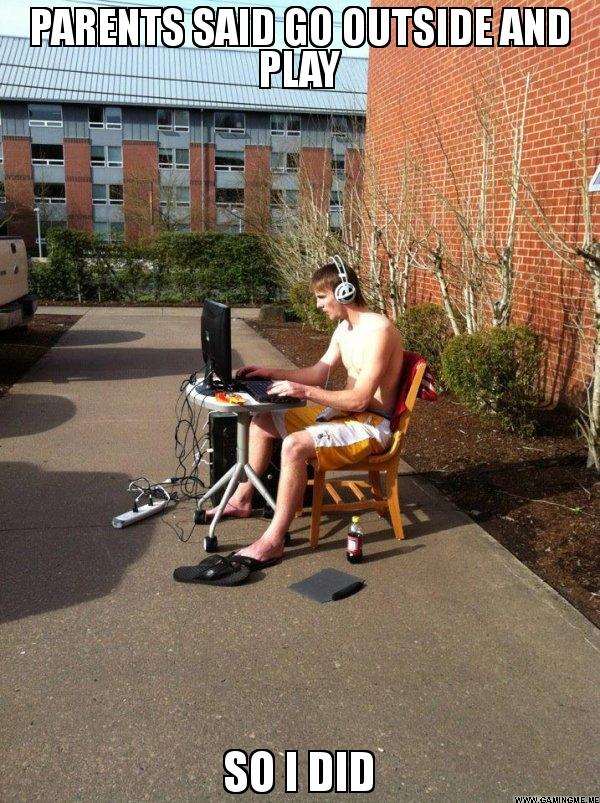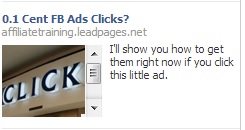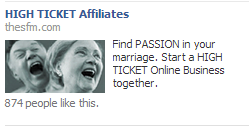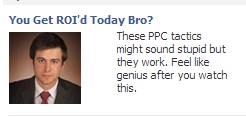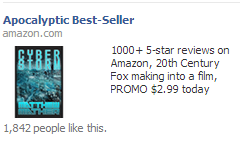Simple Facebook Lead Machines Series
In part 1 of this series I talked about gathering the needed UIDs for your campaign. With these UIDs you will have the distinct advantage of being able to directly market to the people that you want to reach. Hopefully, you have your list of 10,000 – 20,000 UIDs so we can get started with the next step – crafting the ads.
——————————————————————————————————————————–
[social-locker locker_id=”62aca51e0f92e106b” theme=”blue” message=”Share To Download A Printable PDF Version Of This Post” facebook=”true” likeurl=”CURRENT” google=”true” googleurl=”CURRENT” tweet=”true” tweettext=”” tweeturl=”CURRENT” follow=”true” linkedin=”true” linkedinurl=”CURRENT”]Simple Facebook Lead Machines Part 2[/social-locker]
Part 2 – Creating The Ad
In this post you are going to learn some of the many tips, tricks and tactics that I have used when running Facebook ads. This information is coming to you because I have spent and lost enough money to have drawn conclusions about what I think works and what I think doesn’t work.
That being said, read this with a critical eye. Test for yourself. Tweak for yourself.
Your product or service is undoubtedly different than mine. You may require certain techniques that I do not and vice versa. Use this post as a way to get your mind thinking about your own ads and remember:
Marketing is as much art as it is science.
Which Ad Type Is Right For You?
The first decision you need to make before you even THINK about running an ad is to determine what purpose this ad will serve in your overall marketing plan. Do you want to maximize the number of people that “see” your ad? Do you want to maximize the number of people that “click” on your ad? Are you trying to build up a robust Fan Page? What are your goals?
Perhaps in another post at a later date, I will talk more about determining what your goals are in relation to the campaign you’re trying to run. But for now, just keep in mind that you may not necessarily always want clicks directly to your website. As a matter of fact, if you are offering something like a high ticket service, you may not want to have clicks going directly to your website. There are other ways to maximize Facebook ads.
For example, you may want to run ads to build up a fan page for your business. These clicks and “likes” are much cheaper than your traditional CPC through Facebook’s ads. Facebook would prefer to keep their traffic within Facebook, hence the cheaper price.
I disagree with some marketers that claim that a “like” is worth the same as a subscriber on email list, but I will say that having “likes” on a fan page does allow you to repeatedly market to the same people. In a way it is a bit like having subscribers, but my testing has shown that the subscriber value is much higher than “like” value. But again, your business may be different.
The very next decision that you need to make is what type of ad is going to work best for your product. You may not be aware of this already, but there is more than one type of Facebook ad that you could run and you need to choose specifically or you run the risk of losing money.
There are more than this, but I only want to focus on these two for the moment:
1. Sponsored stories
2. Right view ads
Sponsored Stories
Sponsored stories are my favorite type of ad to run when using Facebook ads.
With sponsored stories you are creating an ad that will show up in the newsfeed of those people you are targeting. In other words, you are getting your ad right in front of the area that your Facebook users are checking for. I have found that “sponsored stories” have a much higher CTR (sometimes as much as 10x) and sponsored stories also allow for user engagement.
I am fairly confident that you have seen ads like this running on your own Facebook newsfeed. Facebook has tried to create an advertising experience as close to the actual experience of the Facebook user interacting with their friends as they possibly could. You will find that sometimes “sponsored stories” are commented on, sometimes they received “likes” and sometimes they even receive “shares”.
This type of “social interaction” on a paid ad means that your ad is being seen by additional eyeballs that you are not necessarily paying for. You don’t pay when someone “shares” your ad. That in and of itself is a powerful feature of running “sponsored stories”.
There are two downsides to “sponsored stories” however.
The first is that you must have an associated Facebook fan page in order to run sponsored stories. If you don’t wish to create a fan page for your business, for your product or whatever it is that you’re trying to sell, this is obviously going to be a problem. There are some ways around it (very tricky ways) and perhaps I will teach that in another post some other time, or you can go research “dark posts” and figure out the rest.
Additionally, because ads are being shown to Facebook users and because they are allowed to comment, “like” and “share” your ad, you do get the occasional spammer who will try and “ride” your ad by placing their own links as comments within the sponsored story itself. You will also experience some anger from Facebook users as they get frustrated with seeing ads in their own newsfeed. I have had some pretty negative comments, but if people are so upset with seeing ads in Facebook then they should probably just get off the Internet and go hang outside anyways.
Right View Ads
I’m sure that Facebook has a fancy name for what I call “right view ads” but I don’t know it. “Right view ads” are simply the ads that you see traditionally on the right-hand side of your screen when you’re logged into Facebook.
I still have a great fondness for “right view ads”. They’ve always been good to me.
Later on in this post I’m going to help you construct the best type of ad for the “right view ads” and try and help you maximize your click through rate and conversions etc. but for now just note that “right view ads” do tend to perform less effectively then do “sponsored stories” (at the time of this post).
My General Rules For Choosing Which Type Of Ad To Run
Here are the general rules that I follow with running FB ads:
1. If I am running ads to promote a service (copywriting, consulting, etc.) I want to make sure that I am double dipping and running a “sponsored story”. I want my ad to be shared, I want my ad to get “likes” to my fan page so that I can promote my services to people in the future without having to pay for ads again.
Additionally, if I am promoting a service I can often attach a video to my sponsored story (and I’ll show you how to do that later) which will warm up my prospects before they click through and look at my services.
2. If I am promoting a product, or if I want people to sign up to promote a product of mine, or if I am trying to build an email list, I will typically only run a “right view ad” just because I don’t want to deal with potential spammers or negative comments. Whenever I simply want to “set it and forget it” I go with the “right view ad only”.
Now that you know enough about the two different types of Facebook ads, let’s break down the anatomy of a perfect ad once we get rid of some of those myths that are hanging around the web about FB ads.
Perfect Ad Myths
Before we go into the anatomy of a perfect ad, I want to dispel a few myths that are floating around amongst product creators who are selling untested “how to make money on Facebook” methods.
Myth #1-Outline Your Ads With Red
There is a common misconception floating around the Internet marketing space that putting a red border around your Facebook ad image is going to help your ad performed better.
This is simply not true. Worse, it may actually negatively impact the overall performance of your ads.
You have to remember that advertisements are first impressions. Do you really want the first impression of your business to be a cheesily outlined photo that screams “I’m a skeezy Internet marketer”?
Will a red border on your Facebook ad image increase your CTR? Maybe. I have certainly had non-bordered ads crush those ads I had decided to border.
The point is, that Facebook advertising is a complete sales funnel mindset exercise. You have to put yourself in the shoes of the prospect and ask yourself tough, honest questions about what brand you are trying to build. What kind of people you want to attract? What kind of legacy are you trying to build with your business?
I would bet that if you answered those questions honestly, you wouldn’t be slapping a cheesy red border on your images.
Myth #2-Use Half Naked Women As Ad Photos
Does sex sell? Yes. Yes it does.
But be careful before you start slapping up pictures of half naked women, screaming, tearing their hair out in some awkward angle. Be even more careful if you decided to slap a red border around that.
These ads do get attention. I can’t deny that. I have run ads just like this. They get noticed. They get clicks. They get likes. But they almost never attract the kind of clients that I want and they often end up costing me more per conversion than less scammy looking ads.
The worst thing that you can possibly do is to run deceptive ads. Especially if you decide to run “sponsored stories”. Be careful that you don’t deceive your prospects chasing after a higher click through rate. You will pay for it in your conversions.
Myth #3 – Big Budgets Required
I will tell you right now, that I have never – and probably will never – spent more than five dollars per day on a single ad.
My own personal testing suggests that spending between five dollars and fifteen dollars per day on a single ad will actually yield you higher results in terms of CPC and CPM than if you were to spend fifty dollars or a hundred dollars per day.
Because I don’t actually work in the Facebook advertising department at Facebook, what I am about to say is only speculation and should be treated as such. But…
I believe that the reason that you are able to perform better when you spend less is a direct result of the Facebook algorithm. I believe that big budget companies who are using Facebook will run their ads during certain times of the day and during certain days of the week. During these times Facebook will serve their ads first because of their budget size. Then, when these big budget ads get turned off (whether for the weekend or for the holiday or for the evening) your ads now are being served in their position or place.
In other words, because you have chosen such a small budget you become “filler”. This actually has huge advantages in that your ads are only shown once the more competitive advertisers are no longer advertising. In other words, you have no competition.
Again, this is purely speculation, but this is speculation based off of personal data from running a bunch of ads over the past year. The reality is that it doesn’t matter why, we just now that smaller ad spends yield better CPC and CPM.
Ok, enough with all that garbage, let’s get into crafting amazing ads!
Anatomy Of A Perfect Ad (Part 1) – Right View Ads
Creating Right View Ads is a little different than creating ads for “sponsored stories” and I want to make sure and cover both with enough length that you actually get something useful out of it. So, let’s start with the Right View Ads and then next time I will share with you my strategies for “Sponsored Story” ads.
Right View Ads
Here are a few ads that I have pulled from my swipe file (I recommend creating your own Facebook Ad swipe file by simply doing “print screen” and using Paint to cut out the ads. Save them in a folder and drool over them at your leisure) that I want to show you. These aren’t necessarily my favorite or the best, but they show specific aspects of ad creation that I want to cover.
Again, I HIGHLY recommend that you start a swipe file of your one – especially of ads that you see multiple times.
I will be breaking the ad down by section telling you what works (based on my own testing) and what doesn’t.
Ad 1
What Did And Didn’t Work
Photo: The fact that this photo has a white background means that it breaks the traditional “square block” images our eyes are used to seeing on Facebook. In other words, this different “shape” that this ad takes causes a pattern interrupt in our eyes. I love this tactic. Classier than using big red borders.
Additionally, I like how the arrows are pointing towards the text. I do think that they should have used an actual arrow image instead of just using Paint to draw them in. That does look a bit tacky.
I don’t think the photo really has much to do with the product, which appears to be some type of Facebook marketing product, but at least it isn’t one of those half naked women. I would have looked for other images.
Headline: I have found that question based headlines work really well in Facebook. This headline is clear – you can tell almost right away what this ad is about. The headline contains the suggestion of a promise – “If you click on this ad you will find out how to get clicks for $0.01”. Very well done.
My suggestion for making this ad even better would be to distinguish it even further. In other words to have it say “Want 0.01 Cent FB Clicks?”
The reason I would do that is to reduce the conversion cost of this ad. In a few posts from now we are going to be talking about tracking conversions, but let me just say this:
It is possible that without the “FB” distinction, I could click on that thinking it is about Adwords or Media Buys. Yes, I see that it says “FB Ads” in the text, but this ad headline is strong enough in and of itself that it will garner clicks – so you want to make sure to be specific as to who is clicking on your ad. The more people that you disqualify early on (when using CPC) the cheaper your conversion costs become (we will be talking more about that later in this series).
Text: Nice. Good call to action “Watch The Video Now”. Because this is an ad that links directly to a paid product, I think that the ad creator did a very good job of enticing the click without using the word “Free” which can be really difficult to do.
General: I would consider this a good ad. I am sure it performs well and would imagine that if the owner of the ad is using the UID method of custom audience targeting, then they are more than likely turning a profit running this ad (probably as an affiliate).
Ad 2
What Did And Didn’t Work
Photo: I am pretty sure this is just another ad by the same person, but I thought this ad photo was very clever. Again, this ad creator is using eye pattern interrupt to get our attention. He/she isn’t resorting to bold borders or women screaming. Just different patterns than we are used to seeing. I like it.
You will also see that the image actually says “Click” within it. This call to action is powerful – people will do what you say – you just have to say it.
Headline: This ad has taken the suggestion that I gave for the first one and is doing a much better job of distinguishing between what TYPE of 0.1 cent clicks they are referring to. It does look like a typo and I am not sure the intention of the creator – but the effect still works.
Text: I love the text in this ad. Simple. Straightforward. To the point. Strong call to action. Not trying to hype anything up (which turns people off), not trying to be clever. This truth telling can be powerful in advertising and it works really well here.
General: The power of this ad comes from the fact that it is more targeted (saying FB clicks instead of generic clicks), it uses a great pattern interrupt for the eyes in the scroll bar (that was probably just pasted onto the photo in Paint) and the clear call to action in the text area.
*** Special Note: Between ad 1 and ad 2 you can see how much variation can occur. Even though these ads are promoting the same thing they are different ads. Take this into consideration when we start talking about split-testing and raising conversions by working on our ads.
Ad 3
What Did And Didn’t Work
Photo: Not my favorite photo, but it works. Two elderly people screaming with joy. You don’t see that every day – and it is so in line with the text copy that I have to give it credit. The problems I have with this picture is the color pallet (too similar to Facebook’s) and the screaming faces themselves.
Just to be clear, it isn’t that I don’t like the screaming faces or that I am suggesting the screaming faces aren’t in line with the branding (it appears that they are) I just think that the screaming faces are becoming pattern. We see them all the time. I would caution against their use.
Headline: This is an ok headline, but I chose it to show you something that you can use that IS effective. Do you see how the headline is all caps “HIGH TICKET” and then goes to “Affiliates”? You can also see this in the text area – a variation in all caps and not. This is an effective strategy as it is also a pattern interrupt for the eye.
Additionally, this headline immediately identifies its target – high ticket affiliates – thought it doesn’t really have a strong call to action or attempt to have us read the text.
Text: Let me start with what isn’t working in this text. There is no real call to action. Curiosity is certainly peaked, but curiosity isn’t a call to action. A call to action is “Do this and receive this.” That can’t be found in this text.
That being said…
Humor is a powerful branding tool. Selling with humor is a powerful tactic to learn. The text in this ad may be the most funny text I have ever seen in a Facebook ad. It was so funny that I showed my wife – but I didn’t buy the product. So there you go.
General: Overall I didn’t find this ad effective – but there were parts of this ad that I highly recommend copying. That is the beauty of a swipe file. You don’t even have to analyze the ad right then and there – just toss it in your swipe file and come back to it later, just like I did with this ad.
Ad 4
What Did And Didn’t Work
Photo: Our brain is attracted to the human face. We would rather look at a human face than an object. This ad utilizes that fact really well – in a subtle way. It isn’t a picture of a hot woman (cliche). It isn’t a person screaming (trashy). It is a picture of a dark haired man in a suit. This dark hair, with the dark background and the suit make this ad stand out amongst most IM ads for a few reasons:
1. You hardly ever see a man’s face.
2. The colors are almost opposite the Facebook pallet.
3. He isn’t smiling in this picture.
The photo used in this case is a fantastic instance of pattern interrupt for the eyes.
Headline: I am not a fan of this headline on a personal level, but knowing the IM crowd, I would put my money on this headline working. It has personality, it is a question (remember what I said about questions) and it suggests that this ad is about something semi-specific – ROI.
This headline will attract a very specific type of person. If this ad creator is wanting to attract that type of person (which I think they do) then they have succeeded on a level that you rarely see in Facebook ads. If nothing else, the personality in the ad is superb.
Text: Strong CTA (though it seems to have a typo). “Feel like a genius after watching this.” It may not be the strongest promise ever, but it is a call to action and I would take a weaker CTA over no CTA at all.
General: I picked this one to show you just so that you could see what bringing personality into an ad can do for you. Remember, this is Facebook. This is a SOCIAL NETWORKING SITE. Don’t be stale. You don’t have to copy the personality in this ad, but you should bring your own into your ad creation.
Ad 5
What Did And Didn’t Work
Photo: Using the cover of the book is great if you have a nice cover. The downside of this ad is that the book cover has a similar color pallet to Facebook’s own. This is the opposite of an eye pattern interrupt. Our eyes aren’t necessarily drawn to this image as it doesn’t break blue “square block” pattern that we are used to seeing with these types of ads.
Headline: Fortunately for this ad, the copy is great. “Apocalyptic Best Seller” tells us exactly what it is that is waiting for us behind that ad. I wouldn’t change anything with this headline because of the character limitations. It is specific. It is clear.
If we had more characters to use I would say something like “Buy” and then the rest of the headline, but we don’t.
Text: This is a great text area. Bold promises “1000+ 5 Star Reviews”, “20th Century Fox Making Into A Film”. These are great promises. This ad is saying, “When you click through this ad, this is the kind of book that is waiting for you.” It almost has an implied CTA.
That being said, I think if they took out “PROMO” and added “BUY NOW Only 2.99” it would be stronger.
General: I included this one for its strength in the text area but also to show you how to sell Kindle books using Facebook. If you are trying to market your Kindle book, this is how it is done.
Overall Takeaway From These Ads
I could spend pages upon pages analyzing different ads that I see every day. I recommend that you spend a few minutes a day taking notice of the ads that are running on your feed. Find out for yourself what works for you. What ads are you attracted to? What ads do you click on? Remember that your business is simply an extension of you as a person (or at least it should be) so you really need to find what you are comfortable with and what you want your brand to be.
That being said, let’s recap some general takeaways from these 5 ads that we analyzed:
1. Eye Pattern Interrupts
Forget about red borders on screaming, half naked ladies. Get different. Find new photos. Find photos that are shaped differently. Orient the photo differently. Twist it. Turn it upside down. Get crazy, but remember your brand.
2. Humor As Interrupt
This is Facebook. Be alive. Be funny. Have some fun. Humor is a powerful selling tool and Facebook lets you be wacky – so go for it.
3. Specificity
The more specific you can be the better. Let’s say you own a business that does commercial cleaning, but you only do it for restaurants. If you have an ad that doesn’t specify that you clean for restaurants only, you are going to lose a ton of money on people clicking through your ad thinking that you can help them.
The more specific you get, the cheaper your conversion cost will become.
4. Clarity
Facebook is a fast paced advertising environment. You need to be crystal clear as to why users should click on your ad instead of lurking their friends. If you are having trouble being clear, refer back to rule #3.
5. Question Headlines
Headlines should draw interest, make a promise, and if you can, deliver a CTA. Question headlines are some of the most powerful for creating Facebook ads. Take care to craft your headline.
We will be talking about split testing in a few posts where I will show you how to let your prospective customers choose the best headline for them, but for now just know how important headlines are.
6. Call To Actions
What is a call to action? It is simply telling the reader “Do this and receive this.” Make sure your ad fits that in the text area at the very least. If you can swing it in the headline as well you will have a real winner.
7. Personality
It is important to remember that Facebook is a social networking site. No stiffs aloud! Bring personality into your ads and sit back and watch your ads take off!
Follow these basic principles when creating the Right View Ad in combination with your Custom Audience of highly targeted UIDs and you won’t be able to help but have success!
Resources
Before we wrap this part of the series up, I wanted to leave you with some helpful resources:
My Favorite Place To Find Photos:
Excellent Articles On Building Swipe Files (Must Read):
http://writetodone.com/inspiration-on-demand-create-a-swipe-file/
http://www.copyblogger.com/swipe-file-tips/
Additional Tips On What Makes A Facebook Ad Great From People Much Smarter Than Me:
(Just keep in mind the red banner and “sex sells” stuff we talked about when reading this article)
Next Time…
This concludes Part 2 of the Facebook Lead Machines training series. This post should have gotten your appetite wet for the glory that is Facebook ads and hopefully you feel motivated to go and start your own swipe file of ads that you really like.
The next time that I post we will be talking about “Sponsored Story” ads. I am very excited because they are my favorite and I have lots of gritty little secrets to turn Facebook users into your advertisers for free.
I look forward to seeing you then!
If you liked this post please share it with your friends, coworkers, and yes, even your mother.



